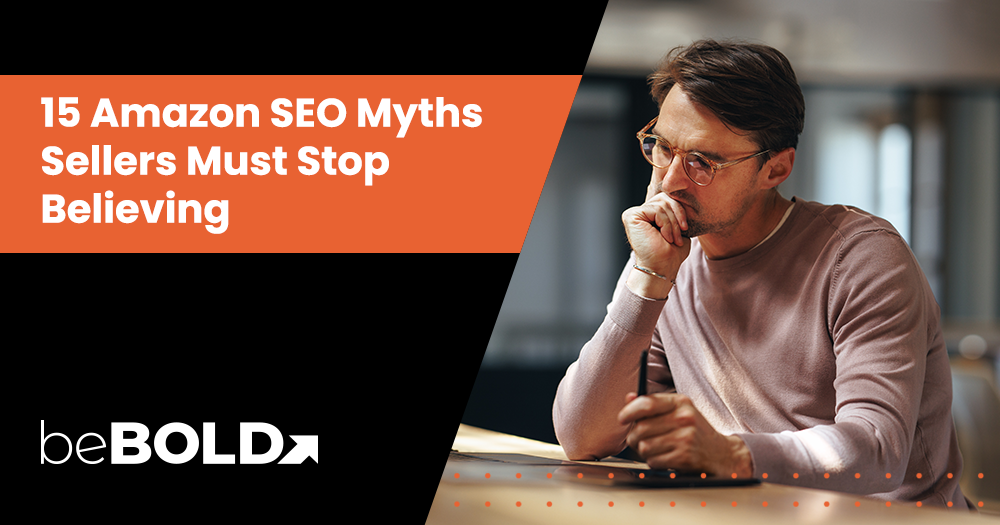Key Highlights
- Misconceptions around Amazon SEO waste time, drain budgets, and hurt sales performance.
- Keyword stuffing in titles or backend terms reduces readability and harms customer experience.
- Product titles matter, but aren’t the only ranking factor; complete listing optimization drives results.
- Strong SEO must pair with sales velocity, pricing, and customer service for higher rankings.
- Data-driven, occasional listing updates improve visibility; frequent random edits confuse the algorithm.
- External traffic sources like social media and ads can support stronger Amazon search rankings.
- Quality, authentic reviews improve conversion rates and rankings; quantity alone doesn’t guarantee success.
- Amazon SEO is an ongoing process requiring consistent updates and strategy adjustments.
- beBOLD Digital empowers Amazon sellers with data-driven strategies that boost visibility, sales, and long-term growth.
Selling on Amazon can feel like navigating a maze, especially when your products aren’t getting the visibility or sales you expect. Often, the culprit isn’t your product; it’s the misconceptions around Amazon SEO that most sellers unknowingly follow. Believing these myths can waste time, drain marketing budgets, and keep your listings buried, while competitors soar past you. This blog uncovers 15 Amazon SEO myths that are hurting your sales and shows you what actually works to improve rankings, visibility, and conversions. By separating fact from fiction, you’ll gain actionable insights to optimize your listings and start turning clicks into real sales.
15 Amazon Myths Related to SEO (And How to Fix Them)
Many Amazon sellers fall prey to common SEO myths that waste time, reduce visibility, and hurt sales. Let’s debunk 15 widespread misconceptions and show actionable strategies to optimize listings and boost performance.
Myth #1: More Keywords = Better Ranking
Stuffing your product listings with every keyword you can think of won’t boost your Amazon search results; in fact, it can hurt your rankings and your customer experience.
Amazon rewards relevance and quality over sheer volume. Focus on strategic keyword placement in titles, bullet points, and product descriptions, backed by thorough keyword research.
Think like a buyer: the right keywords improve visibility, attract qualified shoppers, and ultimately drive higher sales and positive reviews.
For a more detailed guide and tips about Amazon keyword research, you may read our blog on Amazon Keyword Research: 8 Tips You Need Really to Know.
Myth #2: Product Title Is the Only Important Ranking Factor
Your product title matters, but it’s just one piece of the puzzle. Amazon’s ranking algorithm also considers backend keywords, bullet points, product descriptions, sales velocity, and overall seller performance. High conversion rates and strong sales metrics signal to Amazon that your listing satisfies customers, boosting visibility in search results.
Focus on optimizing all listing elements and delivering a great customer experience; this combination drives higher rankings and positive reviews.
Curious how conversion rates impact your Amazon rankings? Explore our blog on Amazon Conversion Rate for practical tips to boost visibility and sales.
Myth #3: Backend Search Terms Should Be Keyword-Stuffed
Backend search terms let Amazon know what your product is about, but stuffing them with every keyword under the sun won’t help.
Relevance matters more than quantity. Avoid repeating words, using brand names, or adding punctuation. Focus on strategic, high-impact keywords that align with what buyers actually search for.
Properly optimized backend terms improve discoverability, enhance your Amazon business, and support higher rankings without compromising seller performance or customer experience.
Want to understand exactly how Amazon ranks your listings? Check out our blog on the Amazon A10 Search Algorithm for SEO for actionable insights.
Myth #4: Good SEO Alone Is Enough to Rank
Even perfectly optimized listings won’t guarantee high rankings. Amazon’s algorithm also weighs sales velocity, conversion rates, pricing, availability, and quality reviews. A product that looks great in search but doesn’t convert or maintain stock signals poor performance, lowering visibility.
To rank higher, combine strong SEO with competitive pricing, fast fulfillment, and excellent customer service. This holistic approach drives sales, builds social proof, and improves your Amazon business metrics.
For a comprehensive checklist on Amazon SEO best practices, you may read our blog on Amazon SEO Checklist.
Myth #5: Frequent Listing Updates Boost Rankings
Constantly tweaking your listings won’t magically improve rankings; in fact, over-editing can confuse Amazon’s algorithm and temporarily hurt visibility.
The key is data-driven updates: monitor metrics like conversion rates, sales performance, and customer feedback, then adjust titles, bullet points, or descriptions based on real insights.
Smart, targeted changes help your product stay competitive, improve the customer experience, and support long-term higher rankings without risking algorithm penalties.
Struggling to make sense of your Amazon performance data? Learn how to track key seller metrics and optimize your listings in our blog on Amazon Seller Metrics Optimization.
Myth #6: External Traffic Doesn’t Help Amazon SEO
Driving traffic from outside Amazon, via social media, Google Ads, or influencer marketing, can actually boost your product’s visibility. When more shoppers click and convert, Amazon sees stronger sales velocity, which improves organic ranking in search results.
Think of external traffic as a way to kickstart momentum: it not only increases immediate sales but also signals to the algorithm that your listing is relevant and in demand, supporting long-term higher rankings.
Want to get your Amazon listings noticed? Learn how leveraging external traffic can boost sales velocity and organic rankings in our blog on Boost Your Amazon Organic Ranking with Amazon Ads.
Myth #7: The More Reviews, the Better the Ranking
It’s not about how many reviews you have; it’s about quality and authenticity. Amazon’s algorithm favors listings with helpful, genuine feedback, and strict policies punish fake or incentivized reviews.
Focus on delivering excellent products, stellar customer service, and follow-up emails requesting honest reviews. High-quality reviews build social proof, boost conversion rates, and naturally improve rankings, helping your Amazon business grow without risking penalties or damaging customer trust.
For actionable strategies on building authentic feedback, check out our guide on how to get reviews on Amazon.
Myth #8: Price Is the Main Factor for SEO
While pricing influences conversions, it isn’t a direct Amazon ranking factor. However, competitive pricing can drive more sales, and higher sales velocity signals relevance to Amazon’s algorithm, indirectly boosting rankings.
Focus on a balance: price your product attractively without compromising margins, and combine it with optimized listings and strong customer service. This strategy improves conversions, builds social proof through positive reviews, and supports long-term higher rankings.
Pricing too low can hurt margins, and pricing too high can slow sales. Get clarity on fees and smart pricing in our guide on how much it costs to sell on Amazon.
Myth #9: Amazon SEO Is a One-Time Task
Amazon SEO isn’t set-and-forget. Competition, customer behavior, and market trends are constantly evolving, meaning what worked last month may not work today. Therefore, regularly review metrics like search performance, conversion rates, and sales velocity to identify areas for improvement.
By making data-driven updates to titles, bullet points, descriptions, and backend keywords, Amazon sellers can stay ahead of competitors, improve rankings, and maintain a strong presence in search results over time.
Boost your Amazon rankings in just 7 steps. Explore our Amazon SEO Strategy guide for actionable tips that actually work.
Myth #10: Only New Sellers Need to Focus on SEO
Even established sellers can’t set it and forget it. Amazon’s algorithm evolves, competition intensifies, and seasonal trends shift buyer behavior. Continuous optimization, like updating titles, bullet points, product descriptions, and backend keywords, is essential to maintain visibility and sales.
Top Amazon sellers monitor metrics, adjust strategies, and stay ahead of competitors. SEO isn’t just for beginners; it’s a critical, ongoing part of sustaining higher rankings and strong sales performance.
Myth #11: Including Your Brand Name in Every Keyword Field Helps SEO
Stuffing your brand name into every keyword field doesn’t improve rankings and wastes valuable space. Amazon prioritizes relevance, so focus on product-related keywords that shoppers are actually searching for. Include your brand name only where it naturally fits, such as in the title or key bullet points.
Smart keyword strategy improves discoverability, supports higher conversion rates, and enhances overall seller performance without compromising your Amazon business metrics.
Myth #12: Long Product Titles Rank Better
Long product titles don’t guarantee higher Amazon rankings. Clarity, relevance, and strategic use of primary keywords matter far more than length. A concise, well-structured title helps shoppers quickly understand your product, improving click-through rates and conversion rates. Overly long titles can confuse buyers and dilute key search terms.
Focus on making your title informative, scannable, and optimized; this balance drives higher rankings and enhances the overall customer experience.
Confused about whether your long titles are hurting clicks instead of helping rankings? Check out our guide on optimizing Amazon product titles for clarity and performance.
Myth #13: Amazon PPC Campaigns Directly Improve Organic Ranking
Running Amazon PPC campaigns increases visibility and drives sales, but it doesn’t directly boost organic rankings. That said, the extra sales and traffic generated can improve sales velocity, which Amazon’s algorithm does consider when ranking products.
Use PPC strategically to promote listings, gather performance data, and drive conversions. When combined with strong SEO and optimized listings, this approach can indirectly support higher organic rankings over time.
Want your PPC campaigns to actually support your rankings? Check out our Amazon PPC Optimization Tips for strategies that boost visibility and sales effectively.
Myth #14: Only Exact Match Keywords Matter
Focusing solely on exact match keywords limits your reach. Broad and partial match keywords can attract relevant traffic that you might otherwise miss. A balanced keyword strategy, mixing exact, broad, and partial matches, ensures your listings appear in a wider range of Amazon search results.
By targeting what shoppers actually search for, you improve visibility, increase clicks, and boost conversion rates, supporting stronger rankings and overall seller performance.
Struggling to move beyond exact match keywords in your campaigns? Explore our Amazon PPC keyword research guide to build a strategy that maximizes reach and conversions.
Myth #15: Using All Available Keyword Space Is Always Best
Maxing out every character with keywords doesn’t automatically improve rankings. Amazon values relevance over volume, so stuffing spaces with redundant or unrelated terms can hurt discoverability.
Focus on carefully chosen, high-impact keywords that match what buyers are actually searching for. Prioritizing quality over quantity enhances your listing’s visibility and improves conversion rates. It also supports better seller performance, helping your Amazon business achieve sustainable, higher rankings without unnecessary clutter.
Turning SEO Myths into Amazon Growth with beBOLD Digital
Believing outdated Amazon SEO myths can quietly drain sales, weaken visibility, and hold your brand back from real growth. The truth is: success on Amazon isn’t about quick fixes, it’s about strategy, precision, and consistent optimization. At beBOLD Digital, we go beyond surface-level tactics by combining data-driven SEO, creative listing optimization, and full-scale Amazon marketing expertise.
Our team partners with you to improve rankings, boost conversions, and build sustainable brand equity on Amazon’s competitive marketplace. Ready to break free from myths and maximize your Amazon potential? Partner with beBOLD Digital today and let us transform your store into a sales powerhouse.
Frequently Asked Questions
Are all Amazon SEO tools reliable, or do some give misleading results?
Not all Amazon SEO tools are fully reliable. Some provide outdated or generalized data. Always cross-check insights with real performance metrics and customer behavior to ensure keyword research, listing optimization, and competitor analysis are accurate and actionable.
Is it true that keyword stuffing boosts Amazon search rankings?
No, keyword stuffing does not improve rankings. Amazon prioritizes relevance, conversion, and customer experience. Overloading listings with keywords can reduce readability, confuse buyers, and even harm seller performance, making strategic, high-quality keyword placement far more effective.
Is using advertising the only way to improve visibility on Amazon, or is that a myth?
It’s an Amazon myth. Paid ads increase visibility but aren’t the only solution. Optimized listings, relevant keywords, competitive pricing, strong reviews, and excellent fulfillment also drive organic rankings and long-term discoverability without relying solely on advertising.
What misconceptions do people have about the role of Amazon SEO experts?
Many think SEO experts can guarantee top rankings or quick results. In reality, they provide strategic guidance, analyze data, optimize listings, and improve visibility, but rankings depend on multiple factors, including sales performance, competition, and buyer behavior.
Is there a secret formula to succeeding with Amazon SEO, or is it mostly about consistent optimization?
There’s no secret formula. Success comes from consistent, data-driven optimization: updating listings, monitoring keywords, analyzing performance, responding to trends, and improving customer experience. Sustainable results require ongoing effort, not a one-time tactic or shortcut.
Are there any myths about Amazon’s search algorithm that hurt seller success?
Yes. Common myths include overemphasizing titles, overstuffing keywords, and thinking sales alone guarantee ranking. Believing these can waste effort, reduce visibility, and hurt conversion rates. Understanding actual ranking factors is key to seller success.
How much does Amazon SEO cost?
Amazon SEO costs vary widely, depending on tools, expert services, and campaign complexity. Sellers can spend anywhere from $50–$500 per month on tools or hundreds to thousands for professional optimization. ROI depends on improved visibility, traffic, and sales.
How do you target your long tail keywords?
Identify specific, less competitive search phrases your audience uses. Integrate them naturally in titles, bullet points, descriptions, and backend keywords. Long tail keywords attract qualified traffic, improve conversion rates, and support higher rankings without excessive competition.
Can new sellers compete with established brands on Amazon, or is ranking mostly determined by sales history?
New sellers can compete on Amazon. While sales history helps, optimized listings, relevant keywords, competitive pricing, and strong customer experience can drive visibility and rankings.
Don’t let outdated SEO myths hold your Amazon business back. Connect with beBOLD Digital for data-driven strategies that improve visibility, boost conversions, and drive sustainable growth. Contact us now.










Comments